Masada
Q186312Roman-Jewish Wars: name of several military engagements between the Roman Republic (later: Empire) and various groups of Jews between 63 BCE and 136 CE.
The Siege of Masada
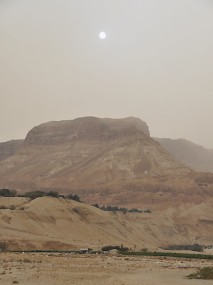
In 70 CE the Romans had destroyed Jerusalem after a war that had lasted for four years. The old city became the bases of the legion X Fretensis and was not rebuilt as a civilian settlement until sixty years later. This was the end of the war, but it turned out that it was not the end of violence.
The Sicarians had occupied Masada - the name means 'citadel' - in the Judaean desert, a fortress situated on a single standing plateau with rough, steep cliffs on all sides, overlooking the Dead Sea. The Sicarian leader was Eleazar son of Yair, a relative of Menahem and Judas the Galilean. There were, it is said, 966 people on the rock -women and children included- and from a Roman perspective, these people were not really dangerous. Masada was miles away from anywhere; merely sending patrols along the towns would be sufficient to make sure that those bandits would not achieve anything and would sooner or later settle somewhere else.
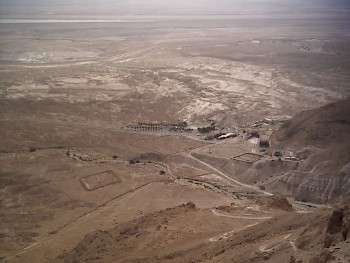
On the other hand, the Jewish revolt, the Civil War of the year 69 and a contemporary rebellion of Batavians in the Rhineland had done much to undermine Roman prestige. In order to boost it again, it was absolutely imperative to win an impressive victory. The Sicarians were an easy target, and as a consequence, the Romans attacked their stronghold in 74. (Some scholars have proposed earlier dates, but archaeologists have found coins from 73 on top of the rock, which makes these earlier dates almost impossible.)
In the spring, the governor of Judaea, Lucius Flavius Silva ordered the legion X Fretensis to build camps around the fortress, and to add a siege ramp. When the siege tower had been rolled forward towards the walls and the legionaries entered the citadel, they discovered that almost all defenders were dead. Searching the buildings, they found a woman and five children; they told the soldiers that the others had decided to commit mass suicide to avoid capture.
This is, in outline, the story that the Jewish historian Flavius Josephus has to tell. It is the final act of the tragedy he has described in the seven books of the Jewish War. In his view, the Sicarians were religious fanatics, who belonged to the Zealot movement which he held responsible for the outbreak of the war and the destruction of Jerusalem. To stress this, he has composed a speech in which Eleazar son of Yair abjures his earlier ideas about the use of violence.
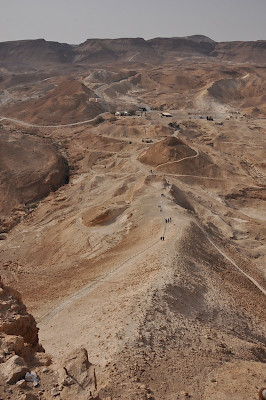
At least, this is what Josephus says. The - admittedly less exciting - truth is that the people who occupied Masada, were neither religious literalists nor fanatic soldiers. The siege is not mentioned in the Jewish sources, because the Jews did not recognize the fall of Masada as part of their history. Josephus himself admits that not all Sicarians were Jews.note and this is confirmed by the fact that archaeologists have found the bones of pigs on the platform. The Sicarians were, to say the least, not deeply attached to the Jewish faith. The archaeologists also discovered the bodies of people who tried to flee from the violence. On the other hand, copies of certain texts found on the rock of Masada were also found at Qumran, which - depending on one's view of the sectarian nature of the Scrolls of the Dead Sea - may or may not prove the presence, among other fighters, of a group of literalists.
Under normal circumstances, Rome would not have bothered about Masada. However, it had suffered humiliating setbacks during the first stage of the war, when X Fretensis lost its eagle standard, and the empire had been suffering from civil war. The defenders of Masada simply had to be killed to reinforce an ancient imperialist superpower's reputation of invincibility.
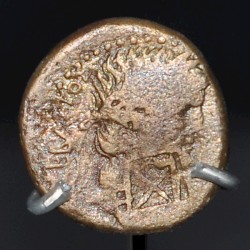 Masada, Coin of Agrippa II, with a mark of X Fretensis |
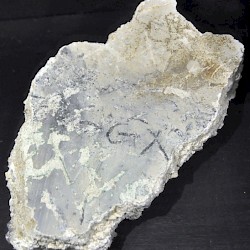 Masada, Graffito by a soldier of X Fretensis |
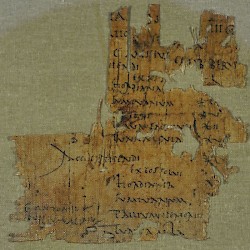 Masada, Payslip of soldiers of X Fretensis |
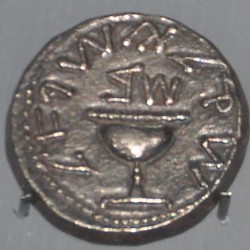 Masada, Rebel coinage |
Literature
Duncan Campbell, "Capturing a Desert Fortress. Flavius Silva and the Siege of Masada", in: Ancient Warfare 4.2 (2010), 28-35